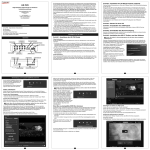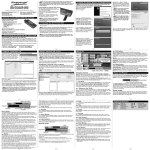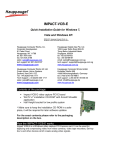Download Hauppauge WinTV-HVR-1250
Transcript
Installing the WinTV driver and WinTV v7 application Install your WinTV products. Turn on your Windows XP, Vista or Windows 7 based PC, and boot into Windows. For Windows XP installations: After you install your WinTV device and boot Windows, a 'Found New Hardware' wizard will appear. Please cancel it and allow Windows to load fully before proceeding. With some WinTV products, you might see this message two or three times. Please click ‘Cancel’ each time you see the New Hardware Wizard. Insert the WinTV Installation CD-ROM in your PC’s CD-ROM drive. For Windows 7: You will see an AutoPlay message. Click Run Setup.exe For all versions of Windows: The “Hauppauge WinTV Installation CD-ROM” window will appear on the screen. ote: if the CD does not autorun, navigate to the CD and run the 'Setup.exe' file. N Step 1. Install the WinTV driver Click the button labeled Step 1: Install Drivers. page 1 A blue screen will open and begin installing the drivers for your WinTV. Once the drivers have installed, a message will appear saying ‘Drivers have been updated successfully’. Click on the bar to exit. You do not need to reboot your PC until after Step 2 ote: the latest driver updates are available at: www.hauppauge.com in the Support section. N Step 2: Install the WinTV applications Click the button labeled Step 2: Install WinTV The setup application will then open and begin automatically installing the WinTV application components. Once complete, click OK then Exit. ote: Save your WinTV Installation CD! You will need it if you download new WinTV applications in the future. N Running WinTV for the first time To run the WinTV v7 application for watching TV, recording videos and playing them back on your PC, double click on the WinTV icon on your Windows desk top. When you run WinTV for the first time, the WinTV Device Setup Wizard appears. Select the TV source that you are using. On some model WinTVs, you have multiple tuners and therefore you can select multiple sources. For the WinTV-HVR-2250, you can chose either ATSC or page 2 Digital QAM and Analog TV. You cannot chose both Digital ATSC and Digital QAM. ote: If you’d like to use the A/V inputs, please see instructions below in External audio/video sources. N If your TV source is ATSC digital over-the-air TV Select Digital ATSC and click Next. In the ATSC Setup menu, click Next. You will see the Digital ATSC Scan scanning for digital over-the-air channels. The digital TV scanning process will scan from channels 2 to 51. As TV channels are found, they will appear in the Channel box. When complete, click Next / Next and OK. ote: if you do not receive any ATSC digital TV channels, an antenna signal booster might be needed. After adding a signal booster, see below for instructions on rescanning and the Troubleshooting section for information on choosing an antenna. N If your TV source is Clear QAM Digital Cable TV Clear QAM digital cable TV channels are those TV channels broadcast on a digital cable network which are unencrypted (‘free to view’). If you are using cable TV with clear QAM programs, chose Digital QAM and Next. QAM channels which are detected but are encrypted are automatically not selected. The resulting channels in the page 3 list might be both standard and high definition channels. If your TV source is Analog cable TV Select your Country and your TV Source from the drop down list. To automatically scan for channels, click Next to continue. Click the Scan button and WinTV will automatically scan for analog channels. The scanning process takes about 10 minutes. External audio/video sources You can bring video into the WinTV from an external audio/video source such as a cable TV or satellite set top box. In the Device Setup Wizard, select External Inputs and click Next. You will be presented with the option to add a Composite and an S-Video Input. Please select your country (if not correct) and click Next. If you wish to connect a source not normally designed for operation in your country, you can configure the Video Format manually from the drop down list. Change the value from “AUTO”. Note: Pal BGHIDK is the commonly used format in Europe. NTSC is the broadcast format used in North America. Rescanning TV channels or adding an external A/V source If you want to rescan for TV channels or add an A/V source (on those products with an external A/V input), click the Configuration menu (Gear button in the page 4 lower left corner of WinTV v7). Then click on the Devices tab. Choose your WinTV device by clicking on it, then click Tuner setup. Chose the TV format you want to scan, then click Next. Click Next and a new scan will be started. When the scan is complete, click Next / Next and OK. Using the WinTV v7 application To watch TV, click the Watch TV button. To see the TV Channel list, click your right mouse button in the TV window to display the Options menu. Select Find Channel. You will see the channel list. To display the channel list all the time, while the channel list is displayed, click the Channel list display always on button. Options menu The Options menu is the main menu where you can select channels, turn on close captions, open the TV Scheduler, show the TV Guide and many other of the Close WinTV WinTV source selector Current channel name and number Channel list display always on Fast channel select numbers TV Channel list Configuration menu (Settings menu) Program Info Record/Pause/Play controls Playback file menu Channel up/down Close captions Watch TV page 5 Volume adjust and mute Options menu click your right mouse button to view Playback menu Channel list TV Scheduler Close captions Always on top most important TV control functions. To bring up the Options Menu, click your right mouse button once in the TV window . To see the channel list, click on Find channel. You will see the list of channels which have been scanned. To show the Channel menu as part of the TV window, click the Channel list always on icon at the top of the channel list. To turn on Close captions, click on Show Captions. To manually schedule a TV recording, or to see which programs have been scheduled, click on Scheduler. To turn on the Always on Top mode, click on Stay on Top. Watch, Pause and Record TV WinTV v7 is always recording video to your PC’s hard drive while TV is being displayed. In this way, you can immediately skip back and replay the TV program you are watching. Clicking on the Pause button will cause the video to pause, while clicking the Record button will cause the current TV program to be recorded to hard disk. page 6 Program Playback Stop info file Settings Record Skip back 1 minute Skip back 10 seconds Skip ahead 30 Skip seconds ahead 1 minute Pause/Play Time bar Recording your TV shows If you want to record a TV show you are watching: - Click the Record button. The recorded file name will popup on the video for a few seconds as the recording starts. Stop button. - When you are finished recording, click the - Click the Playback you just recorded - To play a video you recorded earlier, click the Playback File button and then move your mouse and click once on the video you want to play. Click Open and the file will start playing. file button and select the last file recorded to play the video The recorded video file is saved in the directory set in Recordings directory directory which can be found in the Configuration menu. The default directory is MyVideos. To change this directory, click the Settings button and then the Folders tab. Every time you record a file, a new file is automatically created. The file will be formatted as (ChannelNumber)_(ChannelName)YearMonthDay_TIme. For digital TV programs, the quality level recorded is the same as it is transmitted by the TV station. For example, if the TV station is transmitting a high-definition program, WinTV will record the program in high-definition. Close captions, parental control information and SAP audio are recorded with digital TV programs. For analog cable TV using the built-in hardware MPEG-2 encoder, the quality of the video recording is set to 6Mbits/sec. This will be a configurable setting in a future version of WinTV v7. If you want to pause a TV show you are watching: page 7 - Click the Pause button. Your TV video will stop and the Time counter will start counting. Play button - To start the video from where you paused, click the - To rewind the video to the beginning, click the your video was paused, click the Play button. - To rewind the video 1 minute, click the Skip back 1 minute button. If your video was paused, click the Play button. Skip to the beginning button. If The Delay counter displays how much time you are behind the live video. For example, if the delay counter says 00:01:23, then the video window is showing video 1 minute and 23 seconds behind live video. Configuration menu The WinTV v7 Configuration menu is accessed by clicking the gear button in the lower left hand corner of WinTV v7. General tab: you can set the Video Renderer which allows WinTV v7 to display video with a wide range of graphics systems. page 8 Devices tab: allows is where you can re-scan for TV channels and set up the TV sources in WinTV v7. Parental control tab: is where you can set the Parental Control level. Advanced options: you can set options such as Convert TV recordings to .MPG file type and Game mode here. Selecting FM radio programs On those WinTV products which support FM radio, if you have scanned for FM radio staions in the section entitled “Using WinTV for the first time” you can change the WinTV v7 application to FM by clicking FM radio in the Source selector, found in the upper right hand corner of the WinTV application. IR blaster in WinTV v7 If you would like to use the Hauppauge IR blaster (on those WinTV models with IR blaster built-in) to change the channels on your cable TV or satellite set top box, see the section entitled “Configuring the remote control for WinTV v7”. WinTV v7 TV Scheduler WinTV v7’s built-in TV Scheduler allows you to schedule the recording of TV shows. Once a record event is set, WinTV v7 can be closed and will “wake up” at the desired time and tuned to the desired channel. When a scheduled record event takes place, the WinTV v7 application records “in background” so that you can continue to watch your live TV program, even as the recording progresses. The TV Scheduler can be found in the WinTV v7 Options menu. Right click page 9 your mouse button in the TV window to see the Options menu. Click Scheduler. To set up an event for timed watching or recording, click the Add button. The items that need to be set for each event are: - Name: you can add a name to the recording. If you do not enter a name, the name will be in the channel/date format. - Channel: chose one of your - Start time: set to the desired scanned channels. start time. Click on the hour to set the hour, the minute to set the minute. Note: It takes about 15 seconds to launch the WinTV and start recording. - Duration: number of minutes in the recorded program. - Recurrance: one time, daily, weekly. Note: If you set for Record Weekly, you must also specify the Day of the Week for the recording. - Date to Begin Program: today's date is the default. Change this if you want to schedule on another date. - Source selection: leave set at WinTV to bring up the WinTV at the requested time and on the requested channel. Once these are set, click OK. You can add more recordings, clicking OK after each event is set. When you are finished click Close. The WinTV program does not have to be running for the Schedular to work. If WinTV is not running, it takes about 15 seconds to start WinTV and to start the recording of TV. page 10 WinTV v7 keyboard shortcuts Ctrl A Aspect ratio Ctrl P Play Ctrl D Display the video and audio format of the TV program Alt R Record Alt S Stop Ctrl F Freeze the video Alt T Start TV Ctrl Z Open TV Scheduler Ctrl C Catch up Ctrl O View program details (digital TV program, where provided in the broadcast) Ctrl > Skip ahead Ctrl < Skip back Ctrl S Display subtitles Ctrl W Full screen toggle Alt F Open File menu for playback Alt M Open the Task Menu Alt P Previous channel Ctrl Q Pause page 11 Troubleshooting Some notes on system compatibility Decoding high definition ATSC TV is very CPU intensive. A graphics card with at least 64MBytes of memory and the latest graphics driver from the manufacturer makes the decoding task easier. Typically a 2.2 GHz Pentium 4 processor or equivalent with a graphics card having 64MBytes of memory is required to properly decode ATSC digital TV on your PC. A 1.6GHz AMD Sempro laptop computer tested in the Hauppauge lab used 50% of the CPU for playing ATSC 640i format, and 90% of the CPU when playing ATSC 1080i, the highest definition ATSC format. In some cases, either a faster processor or more graphics memory might be required. Slow or jerky video and a noisy TV picture indicate system performance problems. Jerky video with live ATSC or QAM digital TV Jerky or distorted video can be caused by two things in your PC or laptop: a slow CPU which cannot decode the ATSC TV signal fast enough, and a graphics system which cannot keep up with the high datarates of digital TV. Many times, improving the performance of the graphics display will fix the jerky video display of ATSC digital TV. Here are some tips on improving graphics performance: - Use the latest graphics driver: graphics drivers are often ‘tweaked’ to improve performance, especially the built-in graphics on laptops. Check the Microsoft Windows update site to download the latest graphics driver for your computer. For Dell computers, check the Dell website for the latest graphics driver. - Use WinTV v7 Video Renderer settings to optimize graphics performance: The Video Renderer is found in the General tab of WinTV v7, and is used to change the display mode of a graphics card for TV watching. This setting does not affect any other Windows program. The default mode is EVR. The other modes are VMR9, VMR7 and Overlay. Each mode uses a different process to render video. Try each mode and use the one which gives you the best results. To use hardware graphics acceleration, put a check in the tick box Use hardware acceleration when possible. This will allow your graphics system to use hardware acceleration for video decode. Note: graphics hardware acceleration page 12 does not work on all systems. If this setting does not help, or if you experience WinTV not responding after a channel change, then your graphics system cannot use hardware graphics acceleration. In this case go back to settings and uncheck “use hardware acceleration” and rerun WinTV. Only some channels are found during ATSC channel scan If you are only receiving some known TV channels when scanning, it means your TV antenna is not adequate to pick up the channel. You will need either an antenna signal booster (a Radio Shack antenna amplifier will work) or a high gain antenna. Here’s a link to an ATSC antenna selector: http://www.antennaweb.org/aw/address.aspx Black window when selecting an ATSC channel If analog channels are displayed correctly but you see a black window when selecting an ATSC channels, this means that WinTV is not getting a signal. This is most often due to poor reception. See “Only some channels are found during ATSC channel scan” above. page 13 Uninstalling the WinTV driver and applications Run the hcwclear.exe from the installation CD. Select OK A black screen will briefly appear and once it has disappeared the software will be removed. If you now re-start the computer you will be at Step 4 of the installation. The Hauppauge Remote Control (optional on some models) The WinTV remote control software is installed automatically during the installation of the WinTV applications. You will see the WinTV Remote icon in the Device Tray. The installation will add a shortcut to IR.EXE to the Startup group, so that IR.EXE is loaded every time after Windows has booted. If you need to restart the remote control, select Restart IR from the Start \ All Program Files\WinTV directory. Please ensure the following before trying to use this option: 1. Infrared Remote control - has batteries inserted 2. Infrared-Receiver, is fully connected to the IR socket of the WinTV-Card 3. Infrared software is started - The IR icon is on the start bar To start WinTV press the GO button and a menu will appear. Use the scroll up and down button to select WinTV and press OK to select. Remote control buttons Go button: launches WinTV. Power button (green): close WinTV or launches Windows Media Center. TV button: when WinTV is running, hitting the TV button causes WinTV v7 to go to “live mode” and turns off recording or pause. Red record button: starts recording using the parameters set in the Pref menu. Pause button: if watching live TV, will pause the video. When recording, this button will pause the video but WinTV will continue to record. If playing back video, this button will pause the video playback. Stop button (square icon): stops live TV, the recording or playback. page 14 Play button: plays the last video recorded. Go button Back/Exit button: will close the current menu or exit full screen mode. TV button 0 - 9 buttons: When in “live” TV mode, is used to directly enter channel numbers. When playing back a recording, the “1” button will skip to 10%, the “2” button 20%, etc. of the length of the recording. Skip ahead button: skip ahead 30 seconds. Skip back button: skip back 30 seconds. Go button: Start WinTV. Menu button: opens channel list. Back/Exit button Audio mute Volume up/down Menu Record button Play button Channel up/down Fast rewind Stop button Fast forward Skip back Skip ahead Pause button Red button at bottom: Full screen TV 0-9 “Quick Skip” buttons Green button at bottom: not currently used Yellow button at bottom: not currently used Subtitle button Blue button at bottom: not currently used Sub/CC (#): titles on / off Application on/off Red Green Yellow Blue buttons Sub- page 15 page 16 Configuring the WinTV-HVR-1850 and WinTV-HVR-2250 built-in IR blaster for use with WinTV v7 The IR Configuration Utility is used to configure the WinTV-HVR-2250 and WinTV-HVR-1850’s built-in remote control IR blaster for use with either WinTV v7 or Windows Media Center. ote: the remote control is initially configured for Windows Media Center. If you want to use the IR blaster with WinTV v7, you must run this utility. N To run the IR configuration utility, go to the WinTV program group and click on HCWCIRConfig_Tool.exe (this file can also be found on the WinTV V7 installation CD in the MISC folder). To configure the IR blaster for use with WinTV v7, remove the check from the box labeled Hauppauge WinTV. To configure as a Windows Media Center remote control, put a check in the box labeled “Hauppauge Consumer Infrared Receiver” Click OK to save the changes. ote: your computer must be restarted for the changes to take effect. N Setting up the IR Blaster for use with WinTV v7 In WinTV v7, the IR RemoteBlaster lets the WinTV-HVR board change the channel on a satellite or cable TV set top box by transmitting ‘channel change’ commands to the box via an Infra Red (IR) transmitter. page 17 ote: You will need the remote control from your set top box to complete the configuration in this section. N N ote: this proceedure is only necessary if you are using WinTV v7. If you are using Windows Media Center, it will configure the IR blaster automatically The WinTV-HVR’s IR blaster function consists of two components: 1. IR Blaster cable. This cable has an IR cable jack and an IR transmitter. The IR cable jack plugs into the back of the WinTV board, and the IR transmitter needs to be positioned over the IR receiver on your set top box using the self stick tape supplied on the front of the transmitter. 2. IR Blaster Config program (BlastCfg.EXE) for configuring the codes for the IR transmitter. During the installation of the WinTV applications from the Installation CD-ROM, the Hauppauge IR Blaster applications will be automatically installed. Every time you boot Windows, the IR32 application should automatically run. You will notice a small IR icon in your system device tray. The IR Blaster Configuration program The IR Blaster Configuration program allows you to choose the cable TV or satellite set top box to control, or to “learn” a new set top box. The IR Blaseter Configuration program can be found in the Program Groups / Hauppauge WinTV. Run BlasterCfg.EXE page 18 To set up the IR Blaster, see the guide IRRemoteBlaster Quick Installation Guide for WinTV v7. Learning remote control codes for your set top box Send button First make sure the WinTV IR transmitter is positioned over the remote sensor on your set top box. Remember, the WinTV IR transmitter has a very short transmission distance and needs to be positioned over the remote sensor on your set top box. Key numbers To access the learn function in BlastConfig.exe, click on Advanced Config and Learn. You will need to ‘learn’ the 0 through 9 keys, plus Power on and Enter. To learn the new keys: - hold the remote control from your set top box as close to the Message box IR receiver and learn sensor as possible - in the Blaster config program, click the button you would like to learn (for example: 1) - then depress and hold the corresponding key on your set top box remote control. You will be instructed in the message box when to release the key onyour remote control. Do this for the keys 0 to 9 plus On and Enter You should receive a LearnKey(key#) Succeeded message. Then move on to the next key. If you receive a LearnKey(key#) Failed error, this means that the key was either held down too long, or not long enough, or that the remote was not held close enough to the IR sensor on the HD PVR. Try again. Once you are finished with the numbers 0 to 9 and On and Enter, you can test page 19 the learning by clicking the Send button in the Blaster Configuration program. It will send the numbers 123 to your set top box. Your set top box should now be on channel 123. Close the Blaster Configuration program and your configuration will be saved. page 20






































